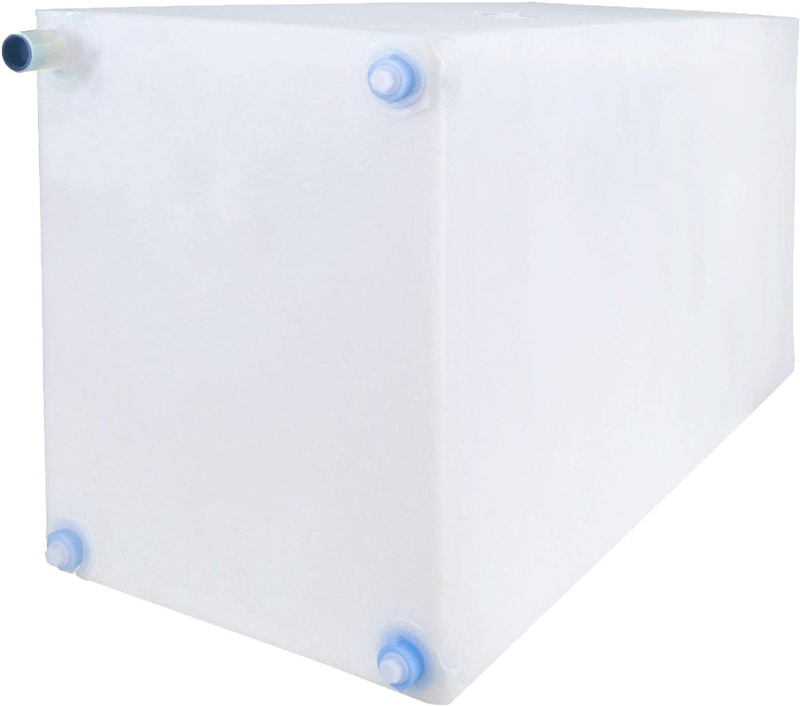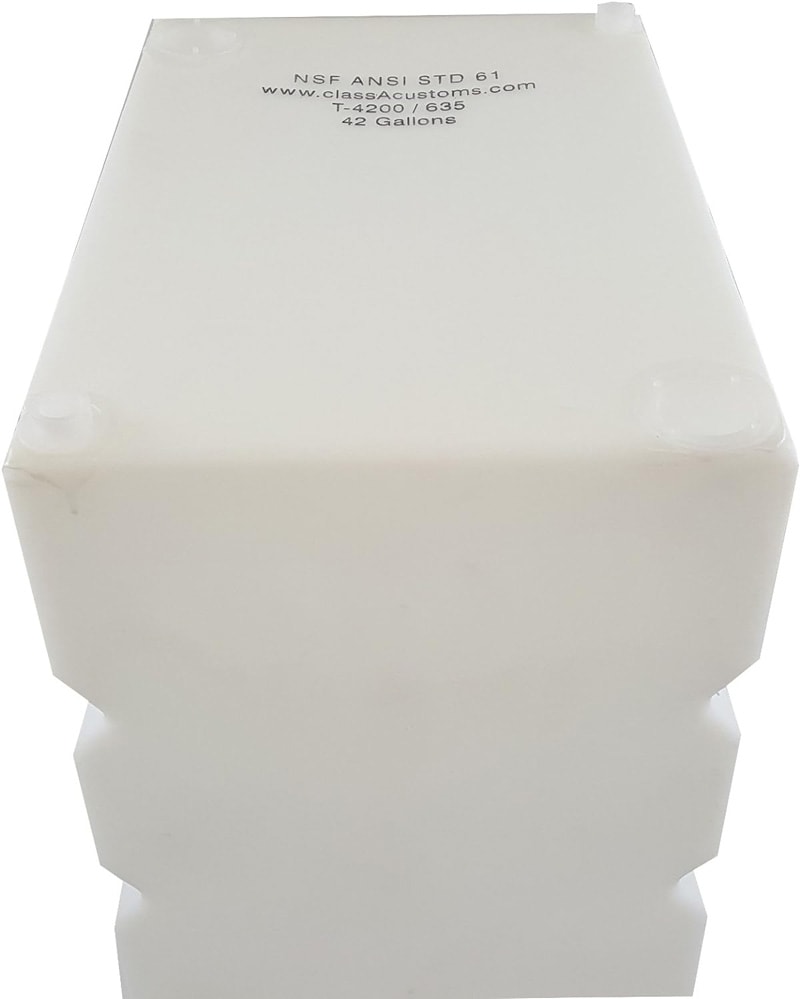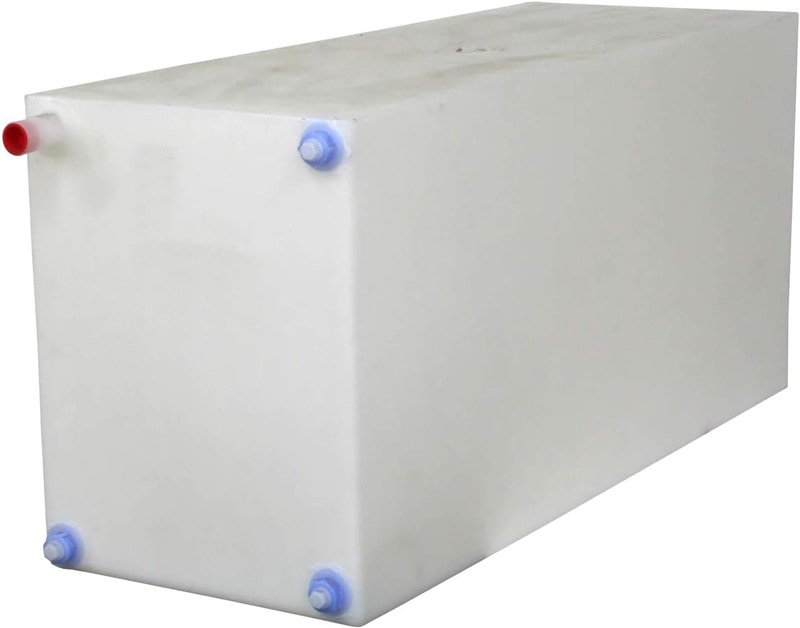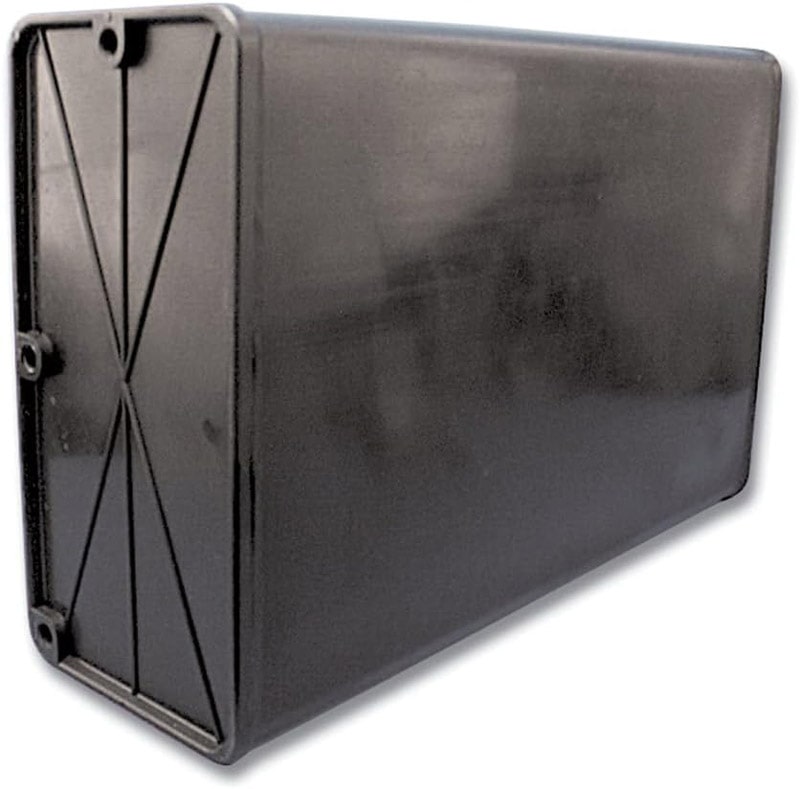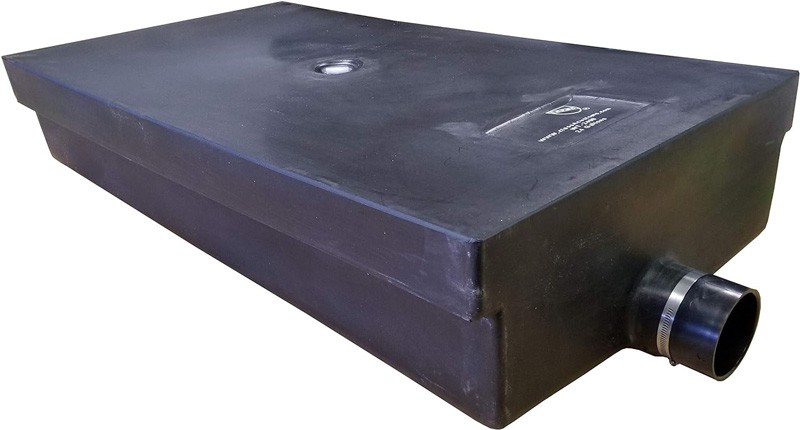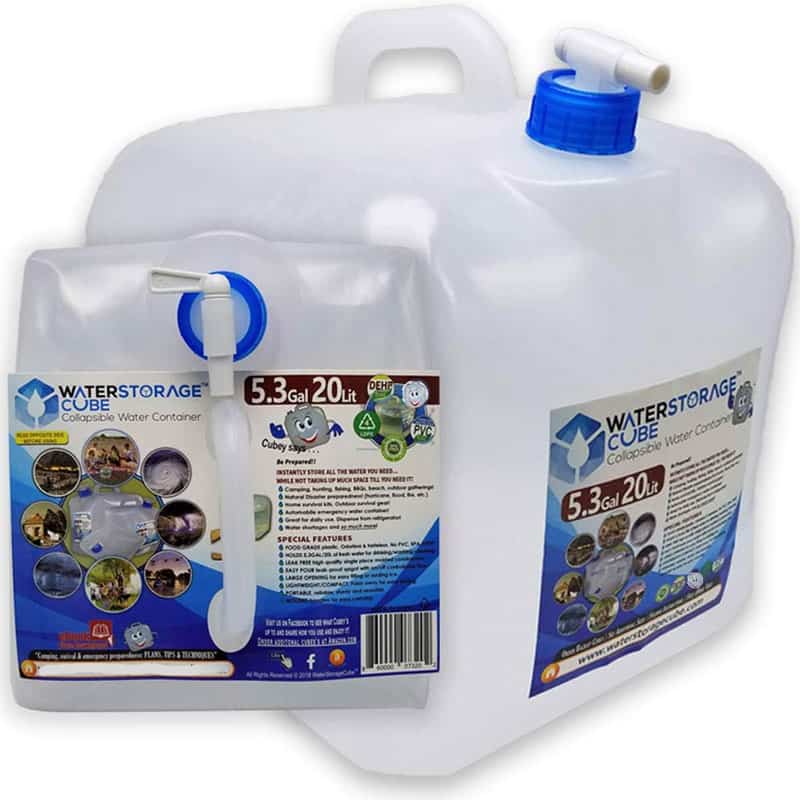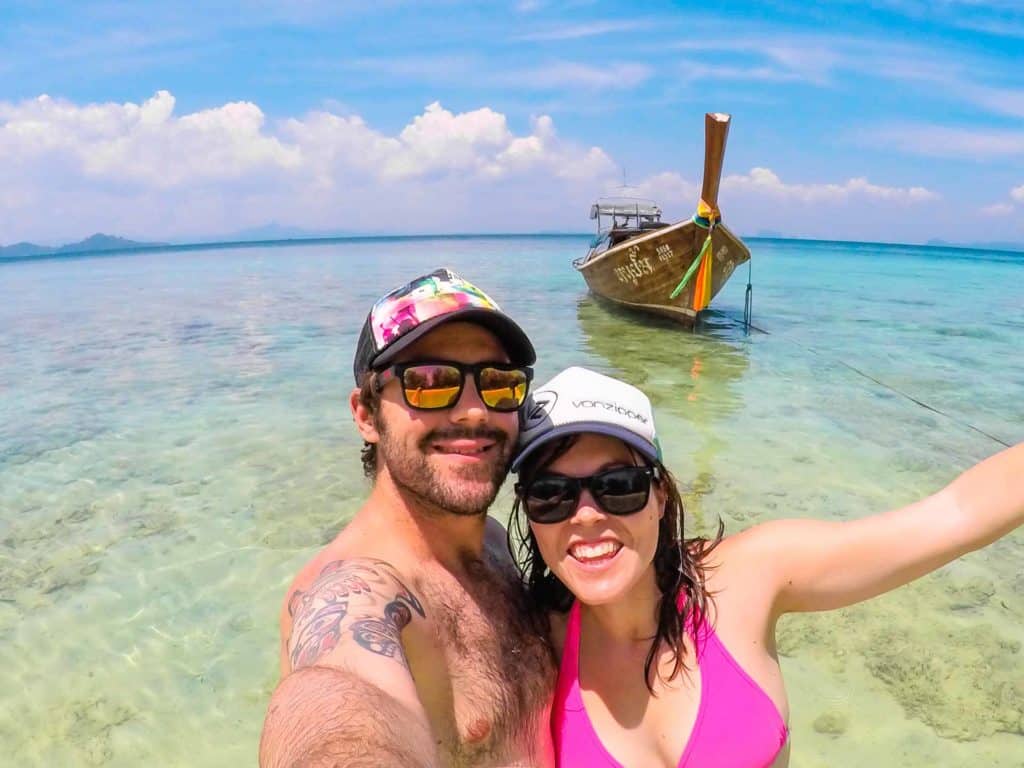Looking for the best campervan water tanks for your van build or upgrade? These are our top 6 recommended caravan water tanks.
There is nothing exciting or sexy about a campervan water system. But as we all know, you can’t live without drinking water for more than a few days, regardless of how Instagrammably beautiful it is wherever you are camping and how great it is to be out in the wild away from everyone.
And even if you got into van life in the first place because you prefer off-grid living, there are other necessities for which you’ll need water.
Washing dishes, grabbing a hot shower or even having a little water to be able to top off the engine coolant system in a bind can all be done with water from your fresh water tank.
But then you also need to consider your van’s water system as a whole when it comes to shopping for campervan water tanks.
You’ll need a waste water tank for your grey water system as well as one for your black water if you have a toilet.
During your van build, you’ll have to consider your plumbing system and water pump for moving water from your freshwater tank to your kitchen sink and outdoor or indoor shower.
When we purchased our most recent motorhome, one of the first things we considered was replacing the drinking water tank that held our fresh water.
We love living off-grid. Between a robust battery bank and an incredibly powerful and efficient solar panel system, the only thing holding us back from weeks of camping off-grid was our tank system.
Ultimately, we kept the tanks we had for the time being due to where they were located and the difficulty in replacing them with anything any larger.
However, when it comes to planning for our next van build, we’re putting our entire water system at the front and center of our decisions.
And we think you should too.
From having a freshwater tank large enough to support 10-14 days of boondocking to a greywater tank capable of holding every drop of wastewater, water storage is our top priority.
Then we can worry about which type of campervan toilet we want, where to place our tankless water heater and which sink and faucet we prefer to match the decor of the build.
But for now, let’s get into our top recommended campervan water tank, which happens to be the one we currently have installed inside our RV.
Our Pick – RecPro 40 gal RV Water Tank
40-gallon capacity is more than enough
BPA-Free so you can trust the water quality in the tank
Durable and rugged construction
Best Product // Our Top Picks at a Glance
| Product | Type | Capacity | Dimensions (inches) | Price Range |
| RecPro 40 gal RV Water Tank | Fresh | 42-gallon | 39 x 18 x 14 | Under $150 |
| Class A Customs | 42 Gallon RV Fresh | Fresh | 42-gallon | 27.5 x 22.5 x 15.3 | Under $150 |
| AA 30 Gal Fresh Water/Grey Tank | Fresh/Grey | 30-gallon | 34 x 18 x 12 | Under $150 |
| Valterra R8030 Grey Water Tank | Grey | 15-gallon | 30 x 16 x 8 | Under $150 |
| Class A Customs WT-2400 24 Gal Black Tank | Black | 24-gallon | 42.5 x 23 x 9.3 | Under $150 |
| WaterStorageCube Collapsible Container | Portable | 5-gallon | 8.5 x 7.7 x 1.6 | Under $20 |
Table of Contents
The Best Campervan Water Tanks
We have gathered a list of the best campervan water tank options for each of the three types of water tanks in your van water system. You will want to start with your fresh water tank and your grey water tank, which incidentally are interchangeable on this list.
And you may or may not need a black water tank depending on how you choose to dispose of human waste in your van. We’ve also listed an option for portable water tanks in the event you do not want to install a permanent tank.
Best Overall: RecPro 40 gal RV Water Tank
The first and most important type of water tank in your campervan water system is a freshwater tank. And RecPro leads the way with their 40-Gal model.
It features an actual capacity of 42 gallons, which is enough to store water for drinking, shower and other essential tasks for 7 to 10 days with normal use.
This water tank is an exceptional tank that can be used both for your freshwater and grey water. With dimensions of 39 x 18 x 14 inches, it is relatively easy to mount in the early stages of your van build.
What we like is that the tank itself is made from seamless plastic with 1/8-inch thick walls to ensure it is the lightest and most durable. The plastic also prevents water from getting contaminated.
It is FDA-approved and BPA-free, which is why we are able to store clean water that can be used for drinking and washing. The tank has a 1.25-inch water inlet and comes with three 3/8-inch outlets with NPT connections to easily attach standard pipes and a water pump.
We also like that RecPro offers this style of freshwater tanks in various capacities if you want to go larger or smaller than the 40-gallon size.
On the downside, the most common complaint is that the outlets are designed at ⅜” but the most common plumbing size for most appliances with vans and recreational vehicles is ½” so you may need to adapt your plumbing along the way.
Other common complaints include some manufacturing defects in a select few in which the tank is cracked or ruptured during delivery. You’ll also want to be sure to wash it out thoroughly as shreds of plastic are common in new water tanks.
Overall, the RecPro is an excellent freshwater tank and you will be glad you opted for the biggest model you can fit and afford in your van build.
PROS
- Strong BPA-free and FDA-approved plastic construction.
- Lightweight.
- Available in various sizes.
CONS
- The outlet size doesn’t match the standard plumbing
- Often has flaws upon delivery
Runner Up: Class A Customs | 42 Gallon RV Fresh
Class A Customs 42 gallons RV water holding tank is a strong product and comparable to its RecPro counterpart in many ways. It is carved from a single piece of plastic, so you will not find any flaws and weak points on the body.
Class A Custom is another American brand specializing in manufacturing water storage and plumbing fittings for campervans. They have terrific high-quality NSF-approved products including this model in a variety of capacities.
The dimensions for this 42 gallons of water storage is almost 12 inches shorter and 5 inches higher than the comparable RecPro model.
It comes with three 1.5” NPT female fittings and two 0.5” NPT fittings, allowing you to orient it the way you want inside your van. The fittings are sealed upon arrival, so you simply cut the membrane to attach your plumbing and water pump.
What we like is that the translucent white plastic tank is see-through to easily evaluate the water level if you do not install water level gauges. Moreover, the BPA-free and NSF-approved material maintains excellent water quality.
According to A Customs, the tanks are built in a warehouse and do not come in a retail box. So minor scratches are normal, but they don’t affect the build quality of the tank.
On the downside, at 26 pounds, this tank is heavier than other plastic-made 42-gallon water tanks. But that can be attributed to higher quality and thicker plastic in the manufacturing process.
Also, be sure that you do not add weight to the top of the tank as this has been known to cause the tank to crack. And, along that line, you also want to make sure that you don’t connect a water hose directly to the tank as it is not pressurized and may crack under pressure.
Instead, install a separate water inlet hose and consider using a pressure regulator to ensure water is delivered to the tank at a reasonable pressure.
All things considered, this is an excellent option for either fresh or greywater systems.
PROS
- Strong, Thick and BPA-free plastic construction.
- Five inlet outlet holes.
- Stable and seamless body.
- Can be mounted in any orientation you desire
CONS
- Heavy
- Can explode if over-pressurized during fill
Best Grey Tank: AA 30 Gal Fresh Water/Grey Tank
- Price Range: Under $150
- Type: Freshwater / Greywater
- Capacity: 30 Gallons
- Dimensions: 34 x 18 x 12 inches
A.A 30-Gal is another solid plastic fresh and grey water tank. Like the later products, it also features a seamless plastic design with no cracks and corners.
Moreover, the body is rust and corrosion-resistant. With 34 x 18 x 12 (L x H x W) inches dimensions AA is a thin and long 30-gallon tank making it a suitable option for grey water storage.
If 30 gallons is too much, and it could be with a camper van conversion, there is also a 10-gallon, 16-gallon and 21-gallon option with correspondingly smaller dimensions.
We like that this tank has a big 1.25 water inlet and three NPT connections to have multiple water outlets. We also like that it is rotational, meaning that it can be mounted in a variety of orientations to suit your van build.
On the downside, the AA tank is only suitable for freshwater and greywater applications. Using it for other purposes can void the warranty, and you don’t want that.
Also, the tank is non-pressurized, so you will have to drill a vent hole or use one of the additional NPT connections for a vent hose if you plan to use a water pump. And as it is a plastic tank, it will also have some scuffing and debris on both sides. So, thoroughly clean the tank with a damp cloth and water.
PROS
- Affordable.
- Available in different size options.
- Thin and extended to fit in tight spaces.
CONS
- Must create a vent hole (not included in manufacturing)
- Sides bulge out when completely filled.
Runner Up: Valtera R8030 Grey Water Tank
The Valterra R8030 defines quality by checking all the boxes of an excellent Grey water tank and is an exceptional product for campervans and RVs.
We’ve included the tank on our shortlist because of its ergonomic underslung design that perfectly fits under the vehicle—keeping the tank hidden under the chassis and making it easy to empty.
We like the overall specs of this particular model. The R8030 is made from solid ABS plastic, weighs only 3 lbs and measures 30 x 16 x 8 inches, which is great for a 15-gallon water tank. Moreover, the material is algae, rust and corrosion-resistant.
We also like that the R8030 is very easy to install. It has six standard threaded screw holes (three on each for horizontal installation) to attach it under the van firmly. The fact that you can order it in a variety of sizes, from 6 gallons up to 36 gallons, is a huge perk for us as you may want larger or smaller grey tank options for your van.
On the downside, the Valterra R8030 can explode under a little pressure. So, avoid using it with a water pump. And be sure to vent it. It also must be installed in a horizontal orientation only, which is usually common for grey tank applications. Standing it on its vertical end will cause it to crack and rupture.
The tank itself is black and does not have a water gauge which is not user-friendly and requires additional components and installation.
PROS
- Great design flawlessly fits under the van.
- Algae, Rust and Corrosion Resistant.
- Easy to Install.
- Lightweight
- Many size options
CONS
- Vulnerable to explode under pressure.
- Must be installed with horizontal orientation only
Best Black Tank: Class A Customs 24 Gal Black Tank
Although black tanks are rare on campervans, we think it is well worth the consideration of this tank if you are thinking about plumbing the urine connection of your composting toilet to a tank rather than a bucket.
The WT-2400 by Class A Customs is a 24-gallon tank that can be used to store black or grey water. At 24 gallons it should hold enough wastewater to handle the entire plumbing system of a campervan for a week or more.
The tank is not suitable for drinking or freshwater as it is made from medium-density polyethylene resin. The material will quickly contaminate the water which is why the tank can only store black water and works with both toilet and sink drain.
Other than that, the material and manufacturing is incredible. It is rust, stain and corrosion resistant and carved from a single piece. Class A Customs WT-2400 is made to fit under the campervan. It has a horizontal design with dimensions 42.5 x 23 x 9.25 (L x W x H), the ideal height for campervans as it does not affect the vehicle’s ground clearance.
The feature that we liked most is the 3-inch female pipe adapter which allows you to easily attach the drainpipe to dump the waste water in RV dump stations. Keep in mind, don’t over-tighten the adapter and pipe as it can damage groves.
The downside of this black water tank is its beefy size. Forty-two inches in length is a considerable size for a 24-gallon black water tank. But its 9.25” lower profile makes it ideal for mounting beneath the van.
PROS
- Handy 3-inch pipe adapter.
- Strong rust, stain and corrosion-resistant body.
- Ample capacity.
CONS
- Massive
Best Portable Tank: WaterStorageCube Collapsible Container
Portable water containers are pretty useful in campervans. They can be used as an emergency resort or you could build your entire campervan water system around the portability of different containers.
The WaterStorageCube is one of the most useful portable water containers because of its collapsibility when not in use.
Surprisingly, it is quite sturdy, especially in the handle, for a portable, collapsible container.
The leakproof bottle also has a one-piece design to ensure rigidity. Moreover, the convenient bottle has a comfortable and thick handle that perfectly fits our hands—making it easier to pick up the 5-gallon bottle.
A typical problem with collapsible bottles is that they are highly prone to catastrophic damage upon falling. But WaterStorageCube is a durable bottle and can withstand multiple falls. You can even sit on the bottle after filling it.
There is one fill port for both dispensing and filling. Unscrew the cap to fill up the container. Then use the spigot (built-in water pump) to easily dispense the right amount of water with a good rate of flow.
The freshwater tank is odorless and tasteless, perfect for storing drinking or filtering water. Moreover, it is made from food-safe PE plastic that is free from BPA and DEHP.
A downside of this portable water container is the spigot. It is prone to start leaking after a few months. You’re also dealing with the fact that this is a portable container and offers only a limited 5-gallon capacity compared to other, larger freshwater tanks.
PROS
- Portability makes it easy to fill in a variety of places
- Tasteless, odorless, BPA-free, DEHP-free build material.
- Handy Spigot and lid combo.
- Robust one-piece design
CONS
- Spigots can leak after a few months.
- Only a portable solution
How to Choose the Best Campervan Water Tanks
Not all campervan water tanks are created the same. And some can serve multiple purposes while others definitely do not. You do not want to mix them up.
In this section, we’ll discuss each of the three types of water tanks you need to consider for your van and get into the details that will help you make the best purchasing decision. From taking a minimalist approach to a portable water tank system to more complex, heavy-duty and permanent installations, we’ll lay it all out for you here.
Types of Water Tanks
There are three types of tanks used in campervans depending on the water they are designed to store.
Fresh Water Tanks
Fresh, or drinking water, is a necessity. These tanks should be used exclusively to store drinking water and nothing else. Of course, you can plumb these tanks to both the shower and kitchen sink for a long hot shower from time to time or to wash the dishes.
But you can’t mix up the purpose of this tank with that of a grey or black tank. You need fresh water when you live in a van and we believe that having the largest possible fresh water tank inside your van that you can reasonably install will serve you in the long run.
But water takes up a huge amount of space and weighs quite a bit. So, you have to get creative with the design choice and placement of the tank. Large tanks may have a small impact on your engine’s fuel consumption and economy due to the weight of water you carry.
But this should not deter you from shopping for a water tank that will suit you for days or weeks on end.
Along with the design, there are many things to consider before getting a freshwater tank. The first thing is the material. It must be strong enough to hold a large amount of water and withstand pressure when moving.
And most importantly, it must be made from food-grade polyethylene. This is essential because the fresh water is for drinking, and it must remain fresh when stored. There are stainless steel tanks, which are algae-resistant but come at a hefty price and are not very common in van life.
The second thing is the access points. A good freshwater tank has a fill port, drain port and air vent. An air vent is necessary as it allows the air to escape when you fill the tank so that it does not explode from too much pressure.
Gray Water Tanks
Grey water comes out of the sink and shower drain and should be stored in a grey water tank. Grey water tanks are usually small as not all freshwater you store results proportionately in grey water.
Because grey wastewater is not toxic, greywater tanks and freshwater tanks are typically interchangeable. In fact, all of the freshwater tanks and greywater tanks on our list are interchangeable in your campervan water system.
Additionally, the fitting requirements are almost the same as the freshwater tanks.
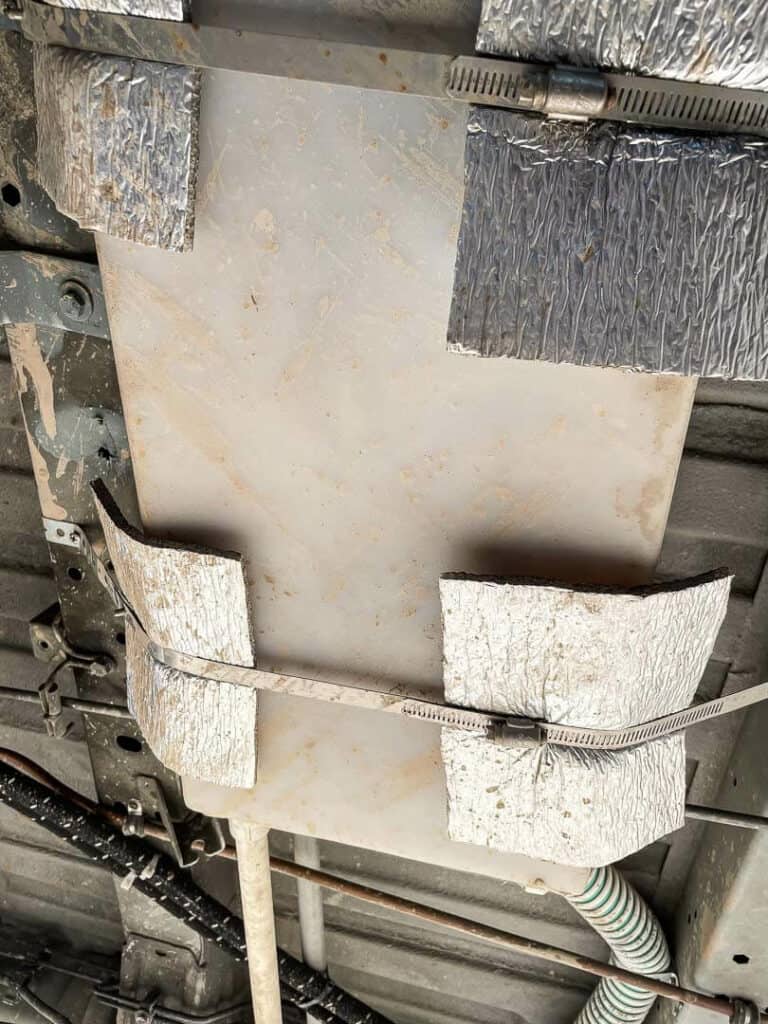
Black Water Tanks
Since most camper van conversions don’t include plumbed toilets you are likely not to include a black water tank in your van. Black water is the wastewater from our toilets. The tanks are typically positioned outside the van directly beneath the toilet to easily dump the waste at a facility.
These permanent tanks are placed under the van as they use gravity to fill and dispense the black water. Moreover, they come in a reasonably big size and can be used to store both grey and black water.
Blackwater tanks will always have a seal and valve to easily dump the waste without creating a mess. They are typically made of a lesser quality plastic which is not safe for storing potable water.
Most black water tanks are low-profile, meaning they are longer and wider but not very tall. This makes it easier to fit beneath the van where they will not be impacted by ground clearance.
Type (Portable vs Fixed)
Most campers in van life will build a campervan water system that uses fixed fresh, black and grey water tanks. But there are portable options for every type.
A campervan water system that incorporates portable tanks will require you to empty and fill them more frequently. While this can be seen as a hassle, it also means that you can do these dumps and refills in more places than those van lifers with fixed water tanks.
For example, if you have a portable greywater system then you are able to carry your container to a pit toilet and dump greywater there or in other appropriate disposal areas.
You can also refill fresh water more conveniently when you do not have a fixed tank. Most grocery stores sell purified water refills by the gallon and you could rely on a water spigot at nearly any business or residence if you were in a bind.
On the other hand, permanently mounted fixed tanks are more ideal for the long-term camper. They are generally larger and more durable and can be mounted in a variety of ways to integrate with a hot water system. Water flow from a fixed tank will typically be drawn by a 12-volt electric pump and then drawn into a hot water heater or directly into the sink, shower and/or toilet.
Fixed water tanks should be mounted securely and in such a way that you account for the weight of the water contained in them. For example, it is a good idea to place a large freshwater tank as close to the rear axle as possible to distribute the weight evenly over the axle as opposed to on the passenger or driver’s side.
Likewise, the grey water system should account for a grey water tank located as close to the center of the van to keep the weight distributed evenly.
In addition to our recommendations for fixed water tanks in this post, there are several companies that will build a custom tank to the specifications of the type of van you are converting.
Wheel well tanks, for instance, can be customized to fit over the wheel well in any of the most common vans for van life. This optimizes the use of space inside your van.
Weight
Water is heavy, at 8 pounds per gallon. A wholly filled 42-gallon tank will weigh 350 pounds or more including the weight of the tank itself. So, it is essential to keep the tank weight as low as possible.
It is equally essential to balance the weight in the van. Putting all the weight on one side will reduce your ability to handle the van safely while driving and increase the risk of wearing out your tire tread unevenly. This will lead to potential flat tires and blowouts which can be dangerous and costly.
If possible, consider placing the water and fuel tank on opposite sides to balance the vehicle. Or consider a wide tank that you can mount evenly between the driver and passenger sides of the van.
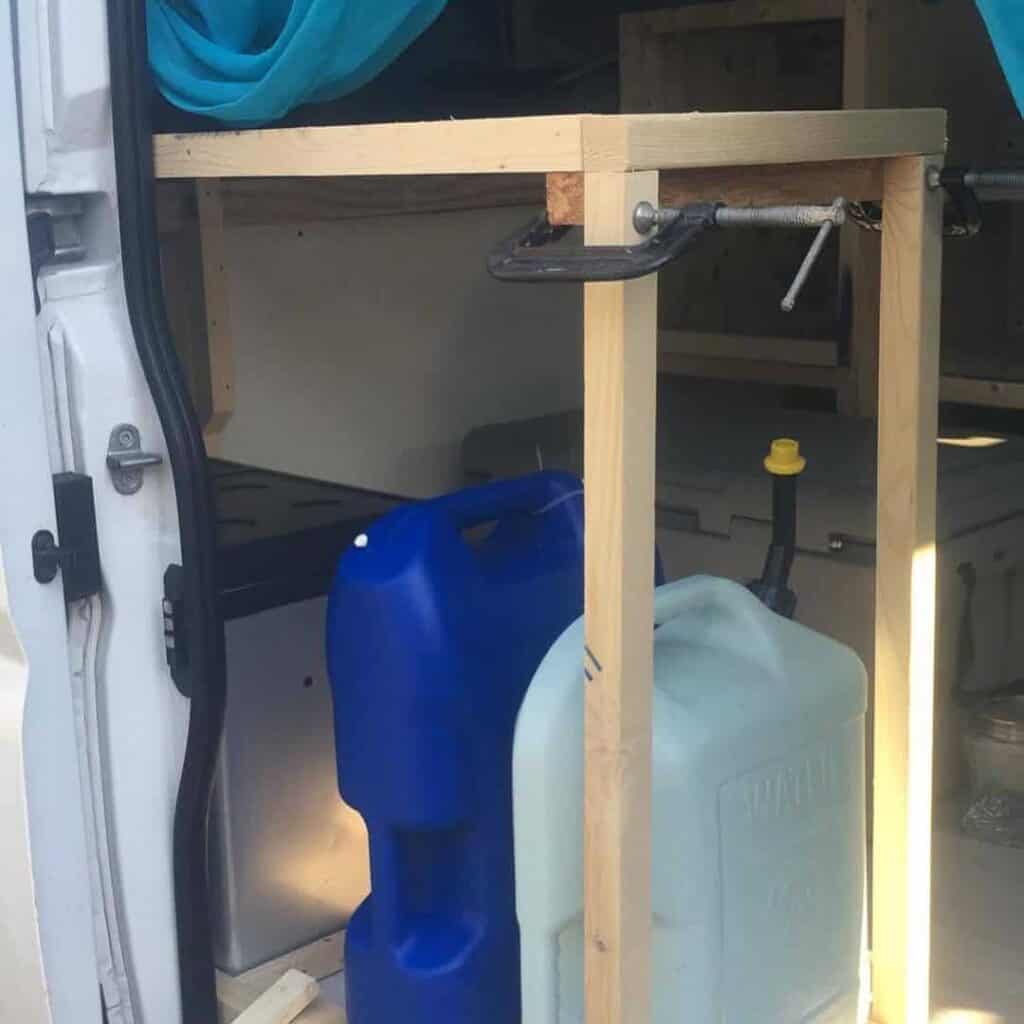
Material
As mentioned above, the material from which the tank is manufactured is vital for a freshwater tank. It must be BPA-free, stain, rust and corrosion resistant to prevent the water from contamination. Usually, the tanks are made from polyethylene as it is safe. However, there is a risk of algae accumulation if not washed for a long time.
If you don’t want algae, a stainless-steel tank will solve your problem. But these tanks are expensive and heavy and not very common in van life.
The material is not as important for grey and black water. You just have to make sure that the tank is strong and durable and mounted properly.
Ease of Install
Installing the tank is not difficult if you have the right place, size, mounts and tools. Freshwater tanks are placed inside the van, and usually, they don’t have screw mounts. You will, however, want to secure the tank so that it does not move during transit.
They are usually mounted in a tight space with braces to prevent any sliding and jumping. The air vent and inlet must be on top with a proper place for the dispensing ports on the bottom.
The important thing is to measure the space twice because the mentioned measurements are approximate and the size can be slightly bigger or smaller.
For under-van grey water tanks, look for a place where there is no moving part nearby. They are mounted on hanging brackets, and their placement must not interfere with the inlet and outlet.
Likewise, look for similar mounting options when installing a black water tank if you happen to use one.
Campervan Water Tank FAQ
Now that we’ve walked through the basics of what to look for in any kind of camper van water system tank, let’s run through some of the most frequently asked questions you may still have.
Do camper vans have water tanks?
Yes. But whether you choose permanently fixed tanks or portable ones is up to you. You will want to account for a source of fresh water and a place to store dirty water at the least.
Most van lifers will have a permanent freshwater tank with a capacity anywhere between 20-40 gallons. From there it is a mix. A majority of vans are equipped with a small 7-10 gallon permanently mounted grey tank.
But there are quite a few people, particularly those van dwellers who do not have an inside shower, who simply collect their sink water in a portable container and empty it as frequently as necessary.
Virtually nobody in van life (aside from higher-end, nicer Class B Leisure Vans) has a black tank as most van toilets are not plumbed RV toilets but rather composting, cassette, portable or bucket options.
What does a campervan water system look like?
If you want to get fresh water in a camper van you can use any of the fresh or grey water tanks on our list. Typically you will plumb a water inlet into the tank near the top of the tank so that it can be completely full.
You will want to have a vent hole with a smaller hose to allow for air to enter the tank as water leaves and to leave the tank as water enters. You’ll also want to install the water outlet near the bottom of the tank such that you can use all of the water in your tank before refilling.
From the water outlet, you will likely have a short hose that connects to your water pump to draw water out of the water tank. As the pumping water moves away from the tank it will then be directed to several appliances, as you so desire, in your van.
You may run one line to the hot water heater to deliver an instant hot water shower. You can run a line from the hot water heater to the sink faucet to deliver hot water for washing dishes and your hands. Likewise, you will likely move cold water to the sink as well.
From there you will be responsible for collecting grey water. If you have an outdoor shower you will not need to worry about collecting grey water as it will simply accumulate on the ground.
But if you have an indoor shower and a faucet you will need to collect that water in a grey water tank, which can easily be plumbed with a pipe from the sink and/or shower drain to the grey tank.
How big of a water tank do I need for a campervan conversion?
This depends on how much water you think you will consume. Based on living in a van for over 4 years, we do not think you should consider anything less than 40 gallons for your freshwater system. If you can reasonably hold more, then we believe that more is better.
A larger freshwater tank will give you the ability to go longer before you have to start the tedious task of finding fresh water.
But on the flip side, a 40-gallon water tank will weigh close to 350 pounds and should be installed in a place that distributes that weight evenly. If you are concerned about either the size or weight of the water tank then you should consider a smaller tank as part of your water system.
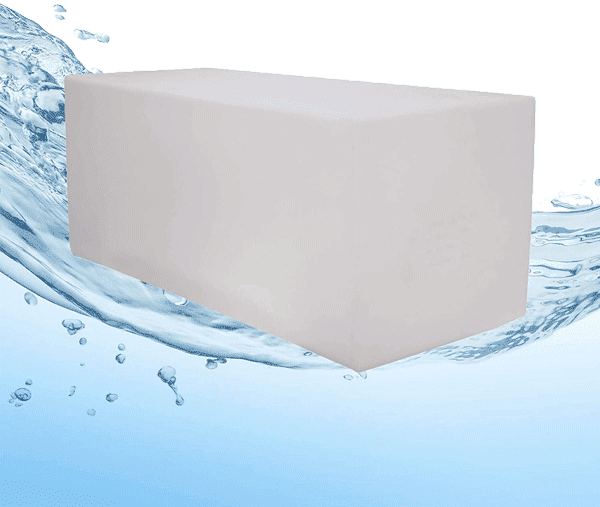
How do you install a water tank in a van?
Water tanks are usually installed near the back of the van. You can use handmade wooden brackets and/or strong cloth belts to secure the tanks in place. Never drill into the tank, for obvious reasons.
Try to avoid having any sharp objects near the tank that may puncture it in the event of fast braking or acceleration. Additionally, do not set any weight on top of the water tank as this can cause it to crack.
Black and grey water tanks are mounted beneath the van using a horizontal bracket. You may need to have these custom-built to accommodate your specific van and tank options.
Try to position each as centrally as possible to account for even weight distribution. And then plumb their release valves to a more accessible part of the van.
Where is the best place to mount a water tank in a van?
It is best to mount a water tank as close to the center of the van as possible. While it is not feasible to install it perfectly in the center of your living space, a good rule of thumb is to keep it centered between the passenger side and driver side and as close to the rear axle as possible.
In this way, the weight is distributed safely in all directions. If you do end up mounting a water tank on either side of your van, be sure to offset the weight on that side of the van with the weight on the other side.
So, for instance, if you mount your water tank on your driver’s side be sure to install your kitchen on the passenger side. Or if your fuel tank is on one side, try installing your water tank on the other side.
You won’t get the weight balanced exactly 50/50. But the more effort you put into installing it correctly the more peace of mind you will have about the handling and safety of the van while driving.
Wrapping Up
Hopefully, by now you know how to choose the best water tanks for your van conversion.
Remember, it is vital to calculate the average water consumption and available space before choosing a water tank. As well as know how to evenly distribute the weight.
Our Pick – RecPro 40 gal RV Water Tank
40-gallon capacity is more than enough
BPA-Free so you can trust the water quality in the tank
Durable and rugged construction
For us, the RecPro 40-Gal RV water tank is the best tank for freshwater and the Class A Customs WT-2400 is ideal for grey and black water.
The RecPro 40 gal RV Water Tank is ideal for any camper purely because of its 40-gallon capacity. Water weighs 8 pounds per gallon, so we’re talking about over 300 pounds of fresh water supply inside this full tank.
Any more and you start to worry about the weight. Any less, and you will find yourself restrained.
Its BPA plastic construction is durable and rugged and can handle the beating sure to come it’s way in the search for great off-road campsites.
There is more than one water pump port so you can build your fresh water system to your water pump in a variety of ways.
DISCLAIMER: Some of the links in this article are affiliate links, which means if you book accommodation, tours or buy a product, we will receive a small commission at no extra cost to you. These commissions help us keep creating more free travel content to help people plan their holidays and adventures. We only recommend the best accommodations, tours and products that ourselves or our fantastic editorial team have personally experienced, and regularly review these. Thanks for your support, kind friend!

